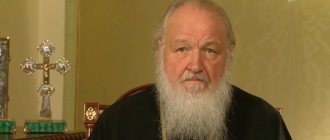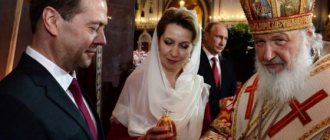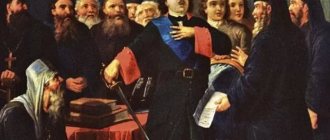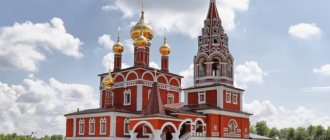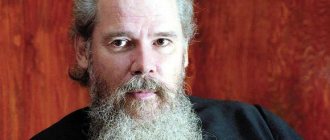The rank of metropolitan occupies a special place in the church hierarchy. He ordains bishops and other priesthood, leads divine services, and addresses the flock with a sermon.
Bishopric is the highest degree of priesthood. There are bishops and there is a Patriarch, almost everyone knows this. There is also a metropolitan in the hierarchy of clergy.
Who is a Metropolitan
In Orthodoxy, clergy of the highest (episcopal) degree bear this title. A clergyman with this title is considered superior to the archbishop and is subordinate to the Patriarch.
Its main difference from other titles of the highest degree is that the metropolitan rules the metropolis and subordinate to him are other bishops with lower titles who govern the dioceses within his metropolis.
A metropolitanate is a collection of several dioceses.
This title was first mentioned in the canons of the First Ecumenical Council in 325. Then in the Roman Empire he ruled the capital, of which there were many in the empire, since it then consisted of many subordinate states. And their main cities were centers of Christianity.
A bishop with such a title is both the successor of the apostles, since initially the disciples of Christ preached in these places, and the head of several bishops at once, which is a very big responsibility. Metropolises were formed naturally; the dioceses that were part of them had common goals and objectives, meetings, and communications.
Drawing. 1. His Beatitude Metropolitan Onuphry of Kiev and All Ukraine at the Easter service
A metropolitan is always a very influential person. It solves serious problems:
- makes significant church decisions;
- interacts with other metropolises;
- monitors the interaction of hierarchies in his metropolis;
- convenes regional Councils and presides over them;
- leads the church in the area entrusted to him;
- without the permission of the metropolitan, bishops subordinate to him cannot resolve important church issues;
- commands bishops: appoints them, relieves them of duties, resolves legal issues related to them, as well as other administrative issues;
- makes sure that the metropolis is one with the church.
In addition to administrative ones, he performs a number of spiritual tasks:
- ordains bishops and other priesthood;
- leads worship services;
- preaches.
There are also metropolitans who do not have power; they play the role of vicars to other metropolitans or to the Patriarch.
In the ancient Church
First known mention of the title Metropolitan
contained in the canons of the First Ecumenical Council (325), which finally determined its place in the church hierarchy.
Councils of provincial bishops (Greek: ἤ ἐπαρχία) were held under the chairmanship of the metropolitans. The 34th Apostolic Canon says directly about them: “It is fitting for the bishops of every nation to know the first of them, and recognize him as the head, and not do anything beyond their authority without him.”
. John Zonara, in his explanations of this canon, calls the leading bishops “bishops of the metropolis.” That is, a metropolitan is the bishop of the center of a particular province of the Roman Empire (also the Byzantine Empire).
The first metropolitan in Rus'
From the 10th century until 1589, there was no patriarch in Rus', and his duties were performed by the metropolitan. Therefore, he, as now the patriarch, was then only one - Kiev and All Rus'. The first bishops with such a title in Rus' were elected and appointed in Constantinople and, naturally, depended on the Patriarch of Constantinople and the emperor. Unlike bishops, they had some independence, because they were the head of the Russian church. But still, they most of all depended on the Kyiv prince.
Priests with this title helped to establish diplomatic relations between the principalities. They also managed to get things related to literature and education off the ground. Until the 13th century, their residence was Kyiv, then Vladimir, and starting from the 14th century - Moscow.
The very first Russian archpastor with this title was Michael I the Syrian, who baptized Prince Vladimir. However, the church was not yet divided into dioceses. Therefore, Michael did not fully possess the power of primate. His successor Leontius succeeded in dividing the church into dioceses. Starting with Hilarion, all primates began to be chosen from Russian people.
Drawing. 2. Saint Alexy of Moscow
Among the metropolitans of the Russian Orthodox Church, several are canonized. Among them, the most famous are the Moscow saints: Alexy, Philip, Macarius, Innocent, Peter, Jonah, Philaret.
Sacraments of the Christian Church
: Baptism; Confirmation; Repentance - confession; Communion; Priesthood is the sacrament of endowing a clergyman with divine grace through episcopal ordination - the blessing of the Lord; Church Marriage (wedding) - blessing by the church before God, sanctification of marital ties; Unction - blessing of oil.
BISHOP
Bishop (Greek ἐπίσκοπος - overseeing, supervising; from ἐπί - on, with + σκοπέω - I look) in the modern Church is a person who has the third, highest degree of priesthood, otherwise bishop (from Greek αρχι - chief, senior + ἱερεύς - priest) . Originally, in apostolic times, the term “bishop,” as used in the letters of the Apostle Paul, denoted the senior leader of a particular community of followers of Jesus Christ. Bishops oversaw the Christians of a particular city or province, as opposed to the apostles (primarily itinerant preachers). Subsequently, the term takes on a more specific meaning of the highest degree of priesthood - above the deacon and presbyterate. With the advent of various episcopal titles - initially honorary - (archbishop, metropolitan, patriarch), the term in Russian also became a designation for the youngest of them, although it did not lose a more general meaning, for which the term bishop is also used (Greek αρχιερεύς). In the Greek-speaking Churches the general term is usually ιεράρχης, that is, hierarch (“priestly leader”). Jesus Christ himself is called by the Apostle Paul in the Epistle to the Hebrews “High Priest according to the order of Melchizedek forever” - Greek. “ὅπου πρόδρομος ὑπὲρ ἡμῶν εἰσῆλθεν Ἰησοῦς, κατὰ τὴν τάξιν Μελχ " (Εβραίους 6:20)
Bishop in New Testament times
In the original Greek text of the New Testament we find 5 mentions of the word Greek. επίσκοπος: Acts (Acts 20:28); Epistle to the Philippians (Phil.1:1); First Epistle to Timothy (1 Tim. 3:2); Epistle to Titus (Titus 1:7); First Epistle of Peter (1 Peter 2:25). In the First Epistle of the Apostle Peter, Jesus Christ himself is called “the Shepherd and Bishop of your souls” (1 Peter 2.25) - Greek. "τὸν ποιμένα καὶ ἐπίσκοπον τῶν ψυχῶν ὑμῶν."
The office of the bishop in various denominations of the Christian Church Canonical foundations and the role of the bishop in the Church
According to the teachings of both the Orthodox and Catholic Churches, one of the essential signs of the canonical legitimacy and validity of the priesthood in general and episcopacy in particular is their apostolic succession, that is, the acceptance of the priesthood from the one who himself received full power in the Church from the Apostles - through consistent and continuous a number of their successors. Apostolic succession is carried out in the Church through bishops. Episcopal consecration (ordination) must be performed by several bishops, at least two bishops (1st Apostolic Canon), except in special cases. As the high priest, the bishop can perform all sacred rites in his diocese: exclusively he has the right to ordain priests, deacons, and consecrate lower clergy, and consecrate antimensions. The name of the bishop is exalted during divine services in all churches of his diocese. Every priest has the right to perform divine services only with the blessing of his ruling bishop. In the Byzantine tradition of Orthodoxy, a visible sign of such a blessing is the antimension issued by the bishop, reclining on the throne of the temple. All monasteries located on the territory of his diocese are also subordinate to the bishop, except for the stauropegial ones, which report directly to the patriarch - the primate of the local church. By the middle of the 7th century, the custom of compulsory celibacy for bishops began to be perceived as the norm, which was enshrined in the 12th and 48th Rules of the Trullo Council (“Fifth and Sixth”). Moreover, the last rule provides: “The wife of someone promoted to episcopal dignity, having previously separated from her husband, by common consent, upon his ordination as a bishop, may she enter a monastery established far from the dwelling of this bishop, and may she enjoy maintenance from the bishop.” In the practice of the Russian Orthodox Church, a custom has been established, which has the force of law, to perform episcopal consecration only over persons who have been tonsured into the minor schema.
Bishop in Orthodoxy Bishopric in Russia
In the 3rd century. There was a Scythian diocese of the Ecumenical Church with its center in Dobrudja, which was subject to the Scythian Christians, who also lived on the lands of modern Russia. According to church tradition, it was with this community of believers, created by the Apostle Andrew, that the spread of the Orthodox faith in Russia began.
Patriarch of Moscow and All Rus' Alexy II in a small episcopal vestment and a green robe
In 961, an unsuccessful visit to Kyiv by the envoy Otto Adalbert (the future first Archbishop of Magdeburg) took place. Usually bishops were approved for ministry by the decision of church hierarchs. The first Metropolitan of Kyiv to arrive in Kyiv for a permanent stay was Michael, Metropolitan of Kiev and All Rus'. In 1147, Metropolitan Kliment Smolyatich was elevated to the Kyiv metropolitanate without the sanction of the throne of Constantinople. This caused a split between the Kyiv metropolitanate and the dioceses of Novgorod, Smolensk, Polotsk and Suzdal. In 1155, Yuri Dolgoruky expelled the “illegal” Metropolitan of Kyiv Clement. The Patriarchate of Constantinople appointed a new Metropolitan of Kiev and All Rus', Constantine I, to the Kiev Metropolitan See. For loyalty in supporting his policies and for supporting Bishop Niphon during the Kyiv schism, the Patriarchate of Constantinople granted autonomy to the Novgorod See. Novgorodians began to elect bishops from among the local clergy at their meeting. Thus, in 1156, the Novgorodians for the first time independently elected Arkady as Archbishop, and in 1228 they removed Archbishop Arseny. The election of Ryazan Bishop Jonah as Metropolitan of Kiev and All Rus' in 1448 marked the actual autocephalization of the Moscow Church (the northeastern part of the Russian Church). Western Russian bishops retained organizational independence from Moscow, remaining under the jurisdiction of Constantinople. In 1162, Prince of Vladimir Andrei Bogolyubsky asked Patriarch of Constantinople Luke Chrysovergus to establish a metropolis in Vladimir, but was refused. With the establishment of the Moscow Patriarchate in 1589, 4 episcopal sees: (Novgorod, Rostov, Kazan and Krutitsk) were transformed into metropolitan sees. But the formation of metropolitan districts (metropolises - following the example of other Eastern Churches) did not happen at that time: all Russian ruling bishops remained equal in their administrative and judicial rights. Metropolitans differed from bishops and archbishops only in the advantages of honor. In fact, from con. XVIII century until the restoration of the patriarchate at the end. 1917, in the Russian Empire there were only 3 dioceses, the bishops of which usually held the rank of metropolitan: St. Petersburg, Kiev and Moscow (since 1818). Since 1852, the title of Metropolitan of Lithuania and Vilna was assigned to the bishops of Vilnius (the first Metropolitan of Lithuania and Vilna was His Eminence Joseph (Semashko)). Currently, the Vilnius metropolitans bear the title Metropolitan of Vilna and Lithuania. Regarding the age limit for those appointed as bishops, the “Nomocanon” (Title I. Chapter 23), which was used in Rus', provides for a minimum age of 35 years for a protege - a candidate -, and in exceptional cases - 25 years. But church history knows deviations from this norm.
The bishop's blue vestment includes a sakkos, omophorion and club. The bishop's blue vestment includes a sakkos
The green vestment of the bishop includes a sakkos, omophorion and club. The red vestment of the bishop includes sakkos, omophorion and club.
The white vestment of the bishop includes a sakkos, an omophorion and a club
Bishops in full episcopal vestments.
A wide ribbon is worn on the sakkos - an omophorion. On their heads are miters. On the chest there is a cross and a panagia (icon). During the service, the bishop symbolizes Christ. Thus, the omophorion ribbon (translated from the Greek omophorion - I carry on my shoulders) symbolizes the lost sheep that the Good Shepherd carries on his shoulder. The miter symbolizes the royal dignity of the bishop, in the likeness of the Kingdom of Christ.
The bishop puts on a robe over his vestments during non-liturgical times. He usually has a monk's hood on his head. The Metropolitan has a white hood. The patriarch has a patriarchal cowl instead of a hood.
Bishop's headdress - miter
An honored priest, he has a miter on his head
The miter is awarded to clergy for special merits or after 30 years of priestly service.
Bishop in the Roman Catholic Church
Bishop's coat of arms Johan Otto von Gemmingen - Catholic bishop
Bishop of Regensburg Gerhard Ludwig Müller
In Catholicism, the bishop has the prerogative to perform not only the sacrament of the priesthood, but also anointing (confirmation). A very special place in the episcopate belongs to the Bishop of Rome, whose special status, developing in the West over the centuries, was secured by the decisions of the First Vatican Council. In accordance with the dogmatic constitution of the Second Vatican Council, Lumen Gentium (proclaimed by Paul VI on November 21, 1964), the institution of collegial participation of bishops in the governance of the Church was created. The Pope serves as the President of the College of Bishops. The Pope, according to the teachings of the Roman Church, “has over the Church, by virtue of his position as the Vicar of Christ and the shepherd of the entire Church, full, supreme and universal power, which he has the right to always freely exercise. The College of Bishops has no power except in union with the Roman Pontiff as its head."
Bishop in Protestantism
Bishops in Protestant denominations are recognized only as temporarily appointed administrative and teaching heads of communities, and not as heirs of special graces or powers that have existed since apostolic times. According to the Reformation view, ministry is not a sacerdotium, a sacrificial ministry, but a ministerium, a serving ministry that should serve the community with the Word of God and the Sacraments. Therefore, in the Augsburg Confession, Article 5, the ministry is called ministerium docendi evangelium et porrigendi sacramenta, the ministry of proclaiming the Gospel and administering the Sacraments, which was instituted by God so that men might receive justifying faith. The episcopate, being an important and useful body in Protestant churches and denominations, is not considered to belong to a special order. Bishops are also called presiding pastors, and their duties include presiding over Conferences, making appointments and ordaining deacons and elders, and generally overseeing the life of the Church.
Metropolitans
Metropolitan of St. Petersburg and Ladoga Vladimir after the end of the service. On his head is a white hood with a diamond cross, an omophorion on his shoulders, and a staff in his hands. The color of the vestment is black because it is Lent.
Vestments of the ever-memorable Metropolitan of Leningrad Nikodim (Rotov) (died 1978). Church and Archaeological Museum of St. Petersburg Theological Academy.
Currently, full-fledged metropolitan districts exist in one form or another within the Russian Orthodox Church.
In particular, these are: - the Latvian Orthodox Church, - the Orthodox Church of Moldova, - the Estonian Orthodox Church, - the Russian Orthodox Church Outside of Russia (ROCOR), - the Ukrainian Orthodox Church, - the Japanese Orthodox Church. In 2011, the Holy Synod adopted the “Regulations on the Metropolises of the Russian Orthodox Church” (these metropolises, which are just a union of dioceses on the territory of a subject of the Russian Federation and do not have autonomy, should be distinguished from metropolitan districts). Metropolitan of Kiev and All Russia
is the title of the primate of the Russian Church during the period when it was part of the Throne of Constantinople, that is, from the time of the Baptism of Russia and the founding of the metropolis in Kiev until 1686, when the Kiev Metropolis, as a result of the annexation of Ukraine to Russia, was annexed to the Moscow Patriarchate.
Metropolitans of Kiev: Michael of Kiev, Leon, John I, Theopemptus, Cyril I, Hilarion of Kiev, Ephraim, George, John II, John III, Nicholas, Nicephorus I, Nikita, Michael II, Clement Smolyatich, Constantine I, Theodore, Constantine II, John IV, Michael III, Nikephoros II, Matthew, Cyril I (II), Joseph, Cyril III. Vladimir period: Maxim, Peter. Moscow period: Theognostus, Alexy, Michael (Mityai), Cyprian, Pimen, Dionysius, Photius, Gerasim, Isidore of Kiev, Jonah Metropolitans of Moscow: Theodosius, Philip I, Gerontius, Zosima, Simon, Varlaam, Daniel, Joseph, Macarius, Athanasius, Philip II (Kolychev), Kirill, Anthony, Dionysius, Job. Patriarchs of All Russia: Saint JOB, IGNATIUS, Hieromartyr HERMOGENES, PHILARET, JOASAPH I, JOSEPH, NIKON, JOASAPH II, PITIRIM, JOAKIM, ADRIAN, Metropolitan of Yaroslavl STEPHAN, Holy Synod, Saint TIKHON, SERGIUS, ALEXIY I, PIMENI, ALEXIY II, KIRILL.
Vestment of His Holiness Patriarch Alexy II (died 2008). The patriarch's headdress is a kukol. Church and Archaeological Museum of St. Petersburg Theological Academy.
RUSSIAN ORTHODOX CHURCH
Nikolai Ugodnik.
Copyright © 2015 Unconditional love
Metropolitan in the Catholic Church
There are several differences between the bishops of the Orthodox Church and the Catholic ones. A Catholic archpastor with such a title has significantly less powers. He is both a metropolitan and an archbishop, heading both the metropolitanate and the archdiocese. Three Catholic bishops with this title are patriarchs: Venice, Lisbon and Jerusalem. They always lead divine services and ordain new bishops. They also accept appeals from the diocesan courts.
How do they become metropolitans?
To achieve such a high rank, you need to go through all the levels of the church hierarchy, starting with the hierodeacon.
Archbishops receive this title for great merit. Only the Patriarch can elevate him to this rank. The primate at the service blesses the worthy archbishop and places a white hood on his head. From that moment on he already bears this title
You can see how this happens in this video:
Church hierarchy
All clergy are divided into black and white. Black are monks who have priestly rank. White - these are married clergy or celibate (not married or monks).
The church hierarchy has 3 degrees: diaconate, priesthood and bishopric. And each of these degrees has its own hierarchy.
Only clergy who have taken monastic vows can have the highest degree. The remaining degrees are available to both white and black clergy. In order to elevate a person to one of the degrees, consecration (ordination) is performed. To have a higher degree, you must complete all lower degrees of the priesthood.
Table 1. Structure of the clergy hierarchy
| Hierarchy level | White priesthood (married and celibate) | Black priesthood (monks) |
| 1 tbsp. Bishopric | Patriarch. Metropolitan. Archbishop. Bishop | |
| 2 tbsp. Presbytery | Archpriest. Priest (presbyter, priest) | Archimandrite. Abbot. Hieromonk |
| 3 tbsp. Diaconate | Protodeacon. Deacon | Archdeacon. Hieromonk |
Links
Presbytery Priest • Hieromonk • Archpriest • Hegumen • Protopresbyter • Archimandrite Diaconate Deaconess • Subdeacon • Deacon • Hierodeacon • Protodeacon • Archdeacon Low clergy Beller • Exorcism • Kirofor • Reader Elders Monsignor (Prothonotary · Prelate Emeritus · Chaplain to His Holiness) · Vicar General · Episcopal Vicar · Canon · Probst · Archpriest · Dean (or District Vicar) · Pastor · Parish Administrator · Parish Vicar · Curate · Assistant Pastor · Chaplain Deacons Deacon · Permanent deacon Servants during the Liturgy Acolyte · Reader · Ceremoniary · Minister (Turiferarium · Cruciferarium) For certain tasks Prefect · Papal Legate · Apostolic Nuncio · Military Ordinary · Apostolic Administrator · Diocesan Administrator · Apostolic Vicar · Apostolic Prefect · Penitentiary · Archdeacon · Primicerium · Rector In Eastern Catholic churches Exarch · Archimandrite In Catholic orders Superior General · Provincial · Primate Abbot · Abbot (Mitred Abbot · Abbot Regular) · Novitius Abolished Royal Cardinal · Lay Cardinal · Prince-Bishop · District Bishop · Antibishop · Prelate Fiocchetto · Abbot Commendatorium · Subdeacon · Exorcist · Ostiary
Rules and recommendations for appealing to the metropolitan
To understand how to correctly address a bishop with such a title, it is important to understand the nature of the address itself. When officially addressed in Orthodoxy, they say “Your Eminence,” but if the address is unofficial, then simply “Vladyka.” For example, to take a blessing from him, you need to say: “Lord, bless.”
Drawing. 3. Parishioners approach the Bishop for a blessing
When addressing clergy, it is imperative to pay due respect to his service. Appeals can be informal or official. In the first case, when addressing a priest or deacon, they call “father and name,” for example, “Father Alexander,” or you can simply “father.” In the second case, deacons are addressed as “Your Reverence,” priests as “Your Reverence,” and archpriests as “Your Reverence.”
When informally addressing bishops, the word “Vladyka” is used. Officially, bishops are called “Your Eminence,” archbishops and metropolitans “Your Eminence.” The Patriarch is always addressed as “Your Holiness.”
Excerpt characterizing the Metropolitan
“I think you won’t touch me,” said Vera, “because there can never be anything bad in my actions.” But I’ll tell mommy how you treat Boris. “Natalya Ilyinishna treats me very well,” said Boris. “I can't complain,” he said. - Leave it, Boris, you are such a diplomat (the word diplomat was in great use among children in the special meaning that they attached to this word); It’s even boring,” Natasha said in an offended, trembling voice. - Why is she pestering me? You will never understand this,” she said, turning to Vera, “because you have never loved anyone; you have no heart, you are only madame de Genlis [Madame Genlis] (this nickname, considered very offensive, was given to Vera by Nikolai), and your first pleasure is to cause trouble for others. “You flirt with Berg as much as you want,” she said quickly. “Yes, I certainly won’t run after a young man in front of the guests...” “Well, I achieved my goal,” Nikolai intervened, “I said unpleasant things to everyone, upset everyone.” Let's go to the nursery. All four, like a frightened flock of birds, got up and left the room. “They told me some troubles, but I didn’t mean anything to anyone,” said Vera. - Madame de Genlis! Madame de Genlis! - Laughing voices said from behind the door. Beautiful Vera, who had such an irritating, unpleasant effect on everyone, smiled and, apparently unaffected by what was said to her, went to the mirror and straightened her scarf and hairstyle. Looking at her beautiful face, she apparently became even colder and calmer. The conversation continued in the living room. - Ah! here,” said the countess, “and in my life tout n’est pas rose.” Don't I see that du train, que nous allons, [not everything is roses. – with our way of life,] our condition will not last long! And all this is the club, and its kindness. We live in the village, do we really relax? Theaters, hunting and God knows what. What can we say about me! Well, how did you arrange it all? I am often amazed at you, Annette, how you, at your age, ride alone in a carriage, to Moscow, to St. Petersburg, to all the ministers, to all the nobility, you know how to get along with everyone, I am surprised! Well, how did it work out? I can't do any of this. - Oh, my soul! - answered Princess Anna Mikhailovna. “God forbid you know how hard it is to remain a widow without support and with a son whom you love to the point of adoration.” “You’ll learn everything,” she continued with some pride. – My process taught me. If I need to see one of these aces, I write a note: “princesse une telle [princess so-and-so] wants to see so-and-so,” and I drive myself in a cab at least two, at least three times, at least four times, until I achieve what I need. I don't care what anyone thinks about me. - Well, well, who did you ask about Borenka? – asked the Countess. - After all, yours is already a guard officer, and Nikolushka is a cadet. There is no one to bother. Who did you ask? - Prince Vasily. He was very nice. Now I agreed to everything, reported to the sovereign,” Princess Anna Mikhailovna said with delight, completely forgetting all the humiliation she went through to achieve her goal. - That he has aged, Prince Vasily? – asked the Countess. – I haven’t seen him since our theaters at the Rumyantsevs’. And I think he forgot about me. “Il me faisait la cour, [He was trailing after me,” the countess recalled with a smile. “Still the same,” answered Anna Mikhailovna, “kind, crumbling.” Les grandeurs ne lui ont pas touriene la tete du tout. [The high position did not turn his head at all.] “I regret that I can do too little for you, dear princess,” he tells me, “order.” No, he is a nice man and a wonderful family member. But you know, Nathalieie, my love for my son. I don't know what I wouldn't do to make him happy. “And my circumstances are so bad,” Anna Mikhailovna continued with sadness and lowering her voice, “so bad that I am now in the most terrible situation. My miserable process is eating up everything I have and is not moving. I don’t have, you can imagine, a la lettre [literally], I don’t have a dime of money, and I don’t know what to outfit Boris with. “She took out a handkerchief and began to cry. “I need five hundred rubles, but I have one twenty-five-ruble note.” I am in this position... My only hope now is Count Kirill Vladimirovich Bezukhov. If he doesn’t want to support his godson - after all, he baptized Borya - and assign him something for his maintenance, then all my troubles will be lost: I will have nothing to outfit him with. The Countess shed tears and silently thought about something. “I often think, maybe this is a sin,” said the princess, “and I often think: Count Kirill Vladimirovich Bezukhoy lives alone... this is a huge fortune... and what does he live for? Life is a burden for him, but Borya is just beginning to live. “He will probably leave something for Boris,” said the countess. - God knows, chere amie! [dear friend!] These rich people and nobles are so selfish. But I’ll still go to him now with Boris and tell him straight out what’s going on. Let them think what they want about me, I really don’t care when my son’s fate depends on it. - The princess stood up. - Now it’s two o’clock, and at four o’clock you have lunch. I'll have time to go. And with the techniques of a St. Petersburg business lady who knows how to use time, Anna Mikhailovna sent for her son and went out into the hall with him. “Farewell, my soul,” she said to the countess, who accompanied her to the door, “wish me success,” she added in a whisper from her son. – Are you visiting Count Kirill Vladimirovich, ma chere? - said the count from the dining room, also going out into the hallway. - If he feels better, invite Pierre to dinner with me. After all, he visited me and danced with the children. Call me by all means, ma chere. Well, let's see how Taras distinguishes himself today. He says that Count Orlov never had such a dinner as we will have. “Mon cher Boris, [Dear Boris,”] said Princess Anna Mikhailovna to her son when Countess Rostova’s carriage, in which they were sitting, drove along the straw-covered street and drove into the wide courtyard of Count Kirill Vladimirovich Bezukhy. “Mon cher Boris,” said the mother, pulling her hand out from under her old coat and with a timid and affectionate movement placing it on her son’s hand, “be gentle, be attentive.” Count Kirill Vladimirovich is still your godfather, and your future fate depends on him. Remember this, mon cher, be as sweet as you know how to be... - If I had known that anything other than humiliation would come of this... - the son answered coldly. “But I promised you and I’m doing this for you.” Despite the fact that someone’s carriage was standing at the entrance, the doorman, looking at the mother and son (who, without ordering to report themselves, directly entered the glass vestibule between two rows of statues in the niches), looking significantly at the old cloak, asked who they wanted whatever, the princesses or the count, and, having learned that the count, said that their Lordships are worse off now and their Lordships do not receive anyone. “We can leave,” the son said in French. - Mon ami! [My friend!] - said the mother in a pleading voice, again touching her son’s hand, as if this touch could calm or excite him. Boris fell silent and, without taking off his overcoat, looked questioningly at his mother. “Darling,” Anna Mikhailovna said in a gentle voice, turning to the doorman, “I know that Count Kirill Vladimirovich is very ill... that’s why I came... I’m a relative... I won’t bother you, dear... But I just need to see Prince Vasily Sergeevich: because he is standing here. Report back, please. The doorman sullenly pulled the string upward and turned away. “Princess Drubetskaya to Prince Vasily Sergeevich,” he shouted to a waiter in stockings, shoes and a tailcoat who had run down from above and was looking out from under the ledge of the stairs. The mother smoothed out the folds of her dyed silk dress, looked into the solid Venetian mirror in the wall and walked briskly up the staircase carpet in her worn-out shoes. “Mon cher, voue m'avez promis, [My friend, you promised me,” she turned again to the Son, exciting him with the touch of her hand. The son, with lowered eyes, calmly followed her. They entered the hall, from which one door led to the chambers allocated to Prince Vasily. While the mother and son, going out into the middle of the room, intended to ask for directions from the old waiter who jumped up at their entrance, a bronze handle turned at one of the doors and Prince Vasily in a velvet fur coat, with one star, in a homely manner, came out, seeing off the handsome black-haired a man. This man was the famous St. Petersburg doctor Lorrain.

